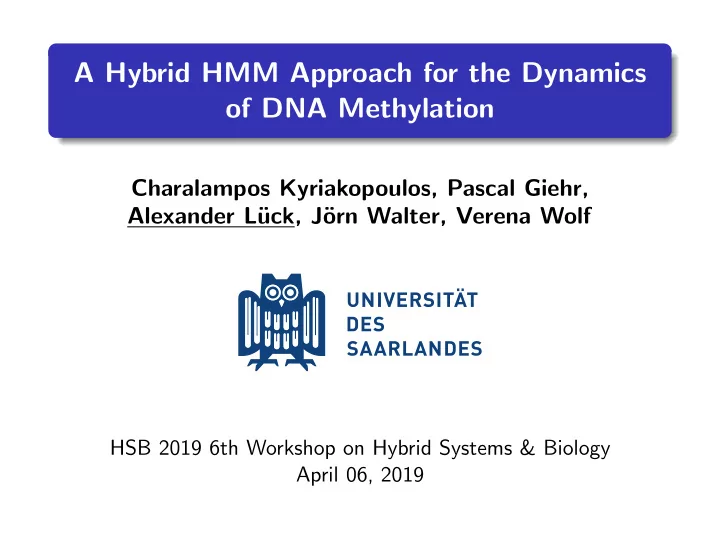

A Hybrid HMM Approach for the Dynamics of DNA Methylation Charalampos Kyriakopoulos, Pascal Giehr, Alexander L¨ uck, J¨ orn Walter, Verena Wolf HSB 2019 6th Workshop on Hybrid Systems & Biology April 06, 2019
Introduction Model Results Importance of Epigenetics Every cell contains the whole genome and therefore the ”blueprints” for all producible proteins. . . . heart skin How can cells specialize? lung DNA brain Why do some cells develop cancer healthy DNA . . . diseases? 1
Introduction Model Results DNA Methylation . . . T A C G C C C T G T C G A. . . . . . A T G C G G G A C A G C T. . . Occurs (almost exclusively) on cytosine in CpGs (DNA sequence: C - Phosphor - G) DNA methyltransferases (Dnmts) convert cytosine (C) to 5-methylcytosine (5mC) C 5mC Methylated cytosine hinders transcription of DNA into mRNA 2
Introduction Model Results Methylation and further modifications C cytosine (C): original unmodified base in DNA DNMT CH 3 5-methylcytosine (5mC): C methylated C → gene inactivation Tet CH 2 OH 5-hydroxymethylcytosine (5hmC): C hydroxymethylated C → gene activation Tet CHO 5-formylcytosine (5fC): formylated C → active demethylation C 3
Introduction Model Results Passive and active demethylation Passive demethylation: Losing methylation over time due to cell division and failed maintenance and/or decreasing methylation efficiency. Active demethylation: η φ 5hmC 5mC 5fC µ C δ d 4
Introduction Model Results Motivation 1 Incorporate different types of event classes in the model: Events that only occur once at deterministic times ( discrete ; cell division and maintenance) and events that may occur more than once at random times ( continuous ; methylation cycle). → Existing models are either exclusively discrete or continuous. 2 Model and predict levels of 5fC. → Important for active demethylation. 5
Introduction Model Results Modeling of (de)methylation events Modeling via Hidden Markov Model with 16 hidden states (4 methylation states on double-stranded DNA) and 4 observable states (2 for each strand). A detailed look into the individual processes: ? Cell division: Keep one strand as it is and synthesize ? a new complementary strand with only unmethylated cytosines. ? Strand to keep is chosen randomly with probability 0.5. ? 6
Introduction Model Results Maintenance methylation Maintenance methylation only on hemi-methylated CpGs (rate µ m ) right after cell division. Assumption based on previous results: No maintenance on μ m μ m hemi-hydroxylated and hemi-formylated CpGs States: C, 5mC, 5hmC, 5fC 7
Introduction Model Results Continuous transitions The reactions de novo µ d hydroxylation η formylation φ demethylation δ may occur more than once in each cell division cycle. States: C, 5mC, 5hmC, 5fC 8
Introduction Model Results Model dynamics Discrete transitions at fixed times t ∈ { t 1 , t 2 , . . . , t n } : Cell division and maintenance (linked to replication fork) → DTMC with transition probability matrix P Continuous transitions at random times t ∈ [ t i , t i +1 ]: Transitions within the methylation cycle ( de novo , hydroxylation, formylation, active demethylation) → CTMC with infinitesimal generator matrix Q Q Q probability P P Q P Q P Q t 1 t 2 t 3 t 4 9
Introduction Model Results Efficiencies Let r ∈ { µ m , µ d , η, φ, δ } , where µ m is a transition probability and µ d , η, φ, δ are transition rates. Time dependent efficiencies, due to e.g. changing enzyme concentrations: r ( t ) := α r + β r · t Introduce bounds in order to ensure identifiability : 0 ≤ r ( t ) ≤ ub Choose ub based on biological assumptions → prohibit arbitrarily fast reactions 10
Introduction Model Results Hidden and observable states Hidden states: C, 5mC, 5hmC and 5fC Observable states: C and T BS oxBS MAB-Seq C m C 5mC 5hmC 5fC C 5mC 5hmC 5fC C 5mC 5hmC 5fC g g g c e c c e d d f d T C C T T C T T T C C T 11
Introduction Model Results Data Example data set: Data for single copy gene Afp (alpha fetoprotein) containing 5 CpGs. Three data sets (BS, oxBS and MAB-Seq) to identify hidden states. Parameter estimation via MLE. Similar results for all 5 CpGs ⇒ Show only aggregated results in the following. 12
Introduction Model Results Observable states BS oxBS MAB-Seq 1 1 1 TT TC CT TT pr TC pr CT pr CC 0.8 0.8 0.8 CC pr frequency 0.6 0.6 0.6 0.4 0.4 0.4 0.2 0.2 0.2 0 0 0 0 1 3 6 0 1 3 6 0 1 3 6 day day day Good agreement between data (solid lines) and results from the model (dashed lines). 13
Introduction Model Results Hidden states 1 0.4 0.4 hm-mh mf-fm uh-hu 0.35 uf-fu 0.35 hf-fh hh 0.8 ff 0.3 0.3 hydroxylation level level per states 0.25 0.25 0.6 5fC level 0.2 0.2 0.4 0.15 0.15 unmethylated fully methylated 0.1 0.1 hemimethylated 0.2 hydroxy formal 0.05 0.05 0 0 0 day0 day1 day3 day6 day0 day1 day3 day6 day0 day1 day3 day6 14
Introduction Model Results Efficiencies 1 0.8 μ m μ d efficiency 0.6 η ϕ 0.4 δ 0.2 0 0 1 2 3 4 5 6 day Measured time points too far apart (only one measurement for each cell division cycle) ⇒ How often was the methylation cycle traversed? No information about intermediate time points. 15
Introduction Model Results Summary Hybrid HMM (discrete for cell division and maintenance; continuous for methylation cycle events) Very flexible model (choice of time points for discrete events, efficiency function) Good prediction performance, however available data is not ideal so far 16
Introduction Model Results Thank you for your attention! 17
Recommend
More recommend